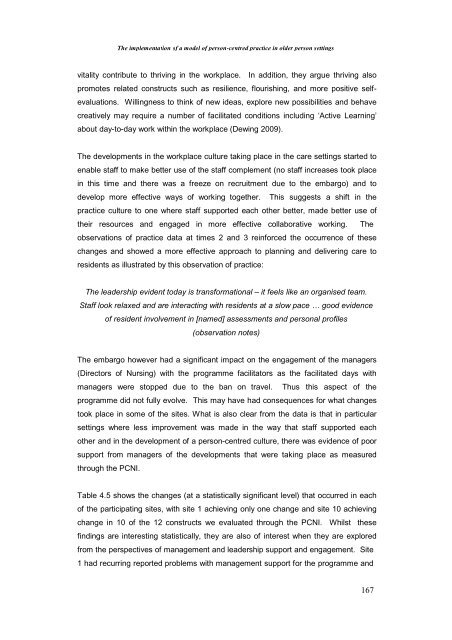The Implementation of a Model of Person-Centred Practice In Older ...
The Implementation of a Model of Person-Centred Practice In Older ...
The Implementation of a Model of Person-Centred Practice In Older ...
You also want an ePaper? Increase the reach of your titles
YUMPU automatically turns print PDFs into web optimized ePapers that Google loves.
<strong>The</strong> implementation <strong>of</strong> a model <strong>of</strong> person-centred practice in older person settings<br />
vitality contribute to thriving in the workplace. <strong>In</strong> addition, they argue thriving also<br />
promotes related constructs such as resilience, flourishing, and more positive selfevaluations.<br />
Willingness to think <strong>of</strong> new ideas, explore new possibilities and behave<br />
creatively may require a number <strong>of</strong> facilitated conditions including ‘Active Learning’<br />
about day-to-day work within the workplace (Dewing 2009).<br />
<strong>The</strong> developments in the workplace culture taking place in the care settings started to<br />
enable staff to make better use <strong>of</strong> the staff complement (no staff increases took place<br />
in this time and there was a freeze on recruitment due to the embargo) and to<br />
develop more effective ways <strong>of</strong> working together. This suggests a shift in the<br />
practice culture to one where staff supported each other better, made better use <strong>of</strong><br />
their resources and engaged in more effective collaborative working. <strong>The</strong><br />
observations <strong>of</strong> practice data at times 2 and 3 reinforced the occurrence <strong>of</strong> these<br />
changes and showed a more effective approach to planning and delivering care to<br />
residents as illustrated by this observation <strong>of</strong> practice:<br />
<strong>The</strong> leadership evident today is transformational – it feels like an organised team.<br />
Staff look relaxed and are interacting with residents at a slow pace … good evidence<br />
<strong>of</strong> resident involvement in [named] assessments and personal pr<strong>of</strong>iles<br />
(observation notes)<br />
<strong>The</strong> embargo however had a significant impact on the engagement <strong>of</strong> the managers<br />
(Directors <strong>of</strong> Nursing) with the programme facilitators as the facilitated days with<br />
managers were stopped due to the ban on travel. Thus this aspect <strong>of</strong> the<br />
programme did not fully evolve. This may have had consequences for what changes<br />
took place in some <strong>of</strong> the sites. What is also clear from the data is that in particular<br />
settings where less improvement was made in the way that staff supported each<br />
other and in the development <strong>of</strong> a person-centred culture, there was evidence <strong>of</strong> poor<br />
support from managers <strong>of</strong> the developments that were taking place as measured<br />
through the PCNI.<br />
Table 4.5 shows the changes (at a statistically significant level) that occurred in each<br />
<strong>of</strong> the participating sites, with site 1 achieving only one change and site 10 achieving<br />
change in 10 <strong>of</strong> the 12 constructs we evaluated through the PCNI. Whilst these<br />
findings are interesting statistically, they are also <strong>of</strong> interest when they are explored<br />
from the perspectives <strong>of</strong> management and leadership support and engagement. Site<br />
1 had recurring reported problems with management support for the programme and<br />
167
















